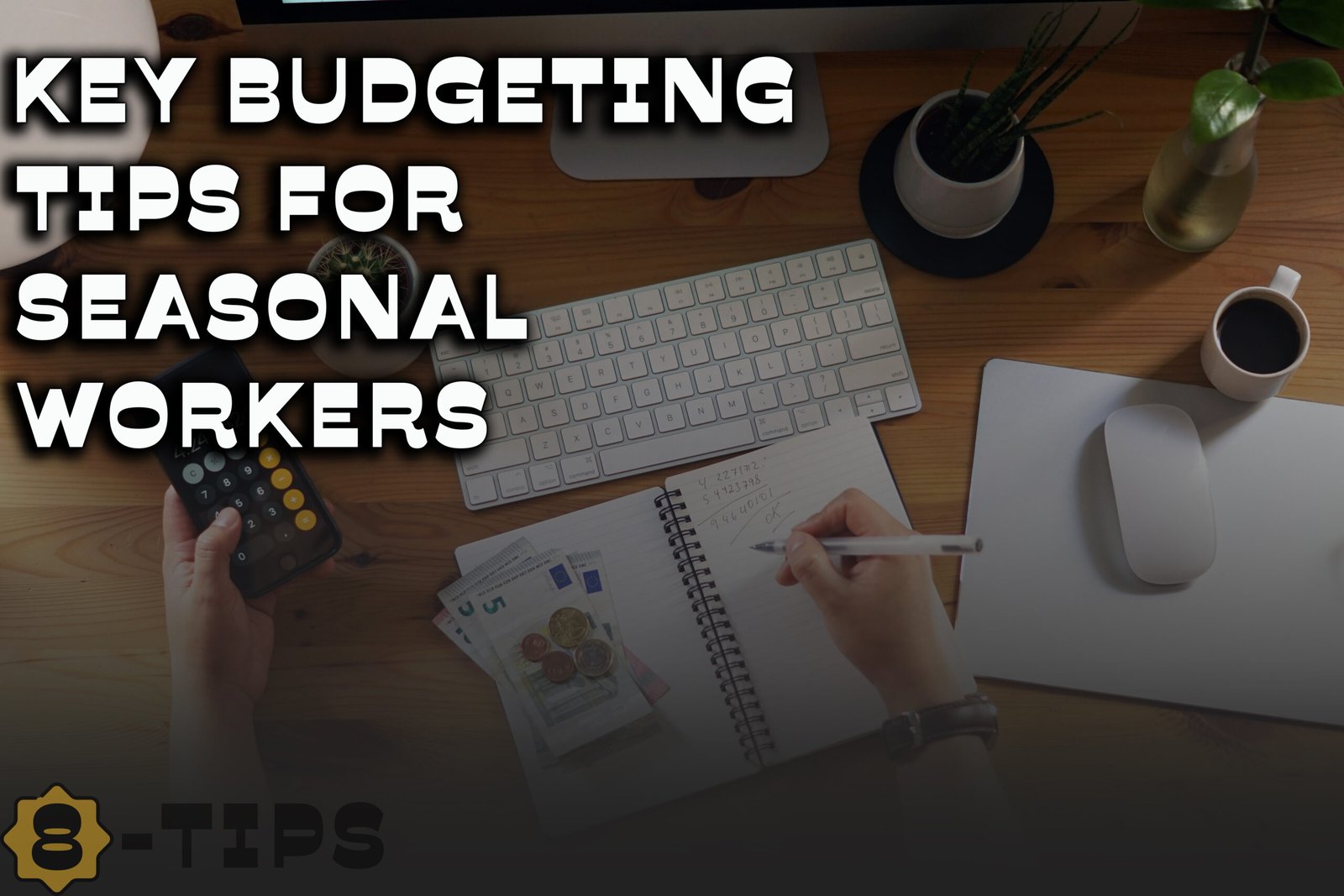This Article will show Key Budgeting Tips for Seasonal Workers. Complete step-by-step guide. Include Advantages and Disadvantages with Frequently Asked Questions and Conclusion.

How do you cope with gaps in income from one job to another?
One of the single most significant money issues for seasonal workers is coping with gaps in income from one job to another. These zero or negative income intervals can be a huge stressor if unplanned and anticipated only in hindsight. The key to resolving this issue starts with imagining your yearly income as a circle, not individual jobs. A good budget plan would have to consider your total annual overall earning potential and budget money accordingly, the off periods between jobs being a factor expected into the equation, not an unpleasant surprise.
One practical method is to make a “lean season budget” for periods when you will not be employed. Estimate your bare essentials—rent, food, utilities, and transport- and how much you’ll need to keep you going through that lean period. Throughout your working years, save to fund the lean season budget. You can work out how much you need and divide it by the number of pay periods throughout your working years, and save the same amount each period.
An off-peak spending savings account will keep you from mixing that money in with your day-to-day spending funds. This overcomes the danger of inadvertently burning through that money. By doing transfers to it automatically when you have more pay months, you’re saving without relying as much on raw willpower.
Finally, be creative and adaptable. In case the employment lag is greater than projected, freelance or part-time work can be used to bridge the gap. Delay discretionary purchases, consume home-cooked meals, and use your downtime to acquire fresh skills or search for higher-paying temporary work. Being proficient at bridging income gaps is not so much pinching pennies but rather planning, being well-informed, and being adept at changing your lifestyle.
Are you budgeting on low-season or high-season revenues?
It’s common for many seasonal employees to fall into the budgeting trap of basing it on the income that occurs only during peak season, and this would create overspending and money worries during the slow times. Rather, it’s important to base your whole year’s budget on your lowest projected income or your average monthly income for a complete year. Budgeting conservatively helps ensure you’re never caught off guard when your paycheck disappears for a while.
Put it in perspective by totaling your estimated yearly income from all seasonal labor and dividing by 12. That’s an actual monthly average and realistic estimate of what you can afford to spend consistently. If you make $24,000 in 6 months’ work, your actual monthly income is $2,000—not the $4,000 you feel when it’s in season. This slight mental adjustment keeps your spending at bay and prevents lifestyle inflation.
This fiscal conservative habit also makes it easier to form an emergency fund because it would normally accrue excess in months of high income. The excess can be channeled into tax savings, medical bills, or an unplanned gap in work. It also encourages responsible planning of big expenses, including holidays or high-end purchases, by timing them at high-fund months.
Conversely, budgeting off-season income is a recipe for complacency. You might sign yourself up for large fixed expenses, like rent or mortgage payments, that are hard to maintain when business is slow. Budgeting off your thinnest months ensures that you sleep better at night and are better prepared to deal with the ebbs and flows of the year.
What do you save in strong-earning months?
Your best opportunity to control your money is in months of high earnings, but only if you can manage them. The temptation to spend and splurge is immense in years of high and regular salaries, but remember: those months will have to bear the burden of the other eleven. Your “financial harvest” months should be a time to reap, save, and budget.
First, prioritize your non-negotiable savings goals, like emergency funds, off-season living costs, and taxes (especially if you’re a 1099 worker or freelancer). Create a plan before the season starts and automate savings so you’re not tempted to spend everything. A good rule of thumb is to set aside at least 40–50% of your income from each peak month for future needs.
Second, prioritize short- and long-term goals. Are you saving for a down payment, college, or career transition? It is time to put these dreams into action. Save some of your money in the form of separate savings accounts with clear names like “Tuition Fund,” “New Business,” or “Winter Bills.” Separating your goals in this way can give you motivation and control.
Also invest if your emergency fund is in place. Invest some of your peak-season income in retirement plans or diversified investments. Even modest investments in strong months accumulate massively in the long term. Long-term investment reduces the reliance on sporadic income and introduces stability to the future.
Lastly, be aware of burnout buys—those “I deserve this” indulgences after a stress-filled workday. Treat yourself with a modest, guilt-free allowance for recreation, but stick to your overall budget. With your savings program in place, high-income months are your best bet for financial freedom, not just a temporary luxury.
How do you handle surprise expenses on a year-round basis?
Surprise bills like maintenance on the car, doctor’s bills, or fix-it on the home can blow a seasonal worker’s budget if one is not anticipating them. They are “when,” not “if,” incidents, so the concept is to be prepared for the shock by having active money processes in place that ease the blow.
The first step is to establish a sinking fund. This is not the same as an emergency fund, which is for actual emergencies, because a sinking fund is for irregular but anticipated expenses. Consider it an “account for future expenses.” Every month, put aside small sums for things like car maintenance, visits to the doctor, or equipment renewal—even though they’re not yet due.
Second, employ insurance as a defensive strategy. If you’re not covered by employer-sponsored plans or are a self-employed individual, purchase cheap liability and health insurance policies through professional associations or government exchanges. Insurance premiums could be a fifth expense, but they generally avoid your having to suffer financially disastrous losses when things go wrong.
It is also prudent to reduce spending commitments wherever one can. Refrain from entering into year-long memberships, leases, or financing agreements that would be difficult to sustain in lean times. Low recurring expenses provide flexibility for you to cover unforeseen expenses without borrowing or cutting back on essentials.
Lastly, mentally (or in writing) keep a list of affordable coping strategies. These are tools such as loaning instead of buying, telemedicine services, negotiation with service providers, or drawing on networks of community support. Financial flexibility isn’t always about spending—sometimes it is about creatively making do with resources in your possession.
Key Budgeting Tips for Seasonal Workers
Seasonal employee budgeting is not just keeping tabs on income—it’s the art of making your paycheck last through months of spotty work. The regular budget method will not do because you are going to be earning a ton of money during parts of the year and nothing at all during other times. Seasonal workers must adopt a specialized budgeting method that offers long-term stability, less money stress, and solid saving habits.
A proper budget takes you through dry spells and still provides you with bare minimums like shelter, food, medication, and transportation. The secret is to budget when income is high and play with your spending when income is low. That implies saving in advance, understanding the difference between fixed and variable costs, having an emergency fund, and making intelligent lifestyle choices on a twelve-month outlook. This budgeting method isn’t merely a matter of getting through the off-season—it’s about using your seasonal revenue year-round.
Seasonal workers also hold various part-time jobs or solo work with different compensation rates, so it is even more difficult to plan your budget. Without a retirement plan or business-paid benefits, you’re the one who must ensure your future is financially secure. Budgeting, therefore, becomes your primary means of financial security, replacing traditional work arrangements with self-control, planning, and thrift.
Regardless of whether you are an event worker, farmhand, or ski instructor, learning and using good budgeting skills can take the unpredictability of seasonal employment and transform it into a successful and empowered way of life. Below are a series of steps that will guide you to being the master of your finances, irrespective of the season.
1. Develop a “Seasonal” Budget Instead of a Monthly Budget
Your seasonal budget likely arrives in lumpy, not regular, installments. Budgeting in these pay periods—rather than the conventional month-to-month plan—smoothes out the money ride. Start with a guesstimate of how much you will have in your peak season, and split it into overall available funds for the year. Your “seasonal budget” keeps you from spending too much cash when you are in a high-cash-flow month and next to lean on when you are low.
Next, enumerate all your annual expenses—like rent, insurance, food, and holiday—and assign a monthly value to each by dividing the annual amounts into monthly portions. Then you will have a sense of what to save each month, even during the lean months. The concept is to spend your annual income as a stream, not about, followed by a dearth of money.
It’s crucial to review your seasonal budget periodically. Accidents, loss of work time, or surprise gigs can alter your anticipated income. By setting up quarterly stopgaps—particularly just before or after the season opens—you can transfer funds to prevent short-term variations from undermining your longer-term financial stability.
Finally, this budgeting plan requires discipline, especially during busy months when temptation is keen. But continuing to redirect excess profits into savings and off-season costs generates a sense of relief and prevents shock during slow business.
- Calculate total income from the working season, and divide it into 12 months.
- Add annual expenses like insurance, vacations, and memberships to the monthly allowance.
- Review and amend the plan at least quarterly to accommodate actual income variations.
- Maintain commitments and save excess profits towards off-season security.
2. Consider an Emergency Fund
Each seasonal worker has unavoidable hazards—equipment failure, flight cancellation, sickness, or an off-season when revenues are skimpy. That is why your second step after budgeting will have to be maintaining a separate emergency fund, ideally 3–6 months of barebones expenses. This cushion is not a frivolity—it’s an insurance policy that makes budgeting more than a gamble.
Make a deliberate effort to put your funds away at the start of the season when there is plenty of revenue. Save first as you pay rent or utilities on a regular paycheck. By putting a portion regularly in a different high-yield savings account, you form a preparation habit and not an urgency one.
Keep the fund intact except for emergencies alone. Don’t touch it when purchasing impulse purchases or “opportunities” that come along during slow periods. When it has to be touched, set up a system to refill it immediately, ideally at the beginning of the next season.
Lastly, think about padding your fund if your season is brief or riskier than normal. A 4 to 6-month buffer gives additional insurance if unexpected situations delay your working dates by a few months or if several slow seasons in succession occur.
- Save for 3–6 months of required expenses.
- Set up regular transfers to a money market or high-yield savings account.
- Only use the fund to cover real emergencies, never discretionary spending.
- Replenish itemized accounts at the start of the new season.
3. Account for All Your Income and Expenses
Seasonal work most typically includes non-traditional schedules, side jobs, and varying pay scales. To remain financially in control, accounting for every dollar is important. Use simple-to-use software like Mint or spreadsheets to deposit money from each job gig—tips, reimbursement, freelance payments, and your everyday expenses.
Make it a weekly habit of tracking money rather than saving it for the last week of the month. This allows you to see patterns, like too much blown on entertainment, or adjust saving targets after a surprise pay alteration. Regular little tracking is easy to maintain and so much more effective than writing all down in one night.
broken down into: housing, utilities, transportation, food, equipment, entertainment, travel, and debt payments/savings. These give a good idea of where money is spent, and where you can save when income decreases.
Finally, schedule a monthly budget vs. actuals review. If you consistently spend too much in a category, make cuts strategically in advance. And if you consistently under-spend, you can likely invest or save towards bigger life goals while you’re working.
- Track all sources of income and spending within a budgeting app.
- Organize transactions into a short description format.
- Use weekly check-ins to be one step ahead of budget slippage.
- Check monthly and scale back on spending or saving as needed.
4. Truncate Off-Season Non-Essential Spending
Having weathered the high season, paying the same price can devastate seasonal budgets. Off-season is when budgeting must occur—cutting or delaying non-essentials, like unused streaming services, dining out, or travel unrelated to work.
Begin by going back through your categories of expense and noting what’s variable, rather than fixed. Clothing (excluding seasonal), entertainment, memberships, and subscriptions need to be checked over. Cut or discontinue whatever isn’t a necessity. Cheap entertainment, such as hiking, a neighborhood potluck, or a free event, needs to be planned.
For big-ticket items, budget ahead. Have car repairs or urgent dental work done in high season if your body allows. Buy by the season and avoid sale-driven “gotta-buy-it-now” sales pressure. Don’t allow discretionary spending to keep up with high-month budgeting, but rather real income.
Lastly, remind yourself often why restraint is important. Imagine your plans—traveling, home buying, or schooling—and how eliminating little expenses now can make them happen sooner. Place the budget on the phone or the wall, reminding everyone of all good decisions.
- Prioritize and contain discretionary spending off-season.
- Eliminate unnecessary membership and subscription fees.
- Budget large expenses when income cycles are at peaks.
- Select inexpensive or no-cost entertainment to remain in harmony with your budget.
5. Tap Off‑Season Work or Side Hustles
Underemployment off-season is not the same as no income. Side hustles such as freelancing, delivery, or tutoring can fill an income gap and maintain your skills. Employ local job boards or apps such as TaskRabbit, Upwork, or Fiverr to locate work that harmonizes with your schedule.
Remote or gig work is one means of filling in fiscal gaps, but treat it as planned income—not ancillary income to be spent. Invest 50–70% of its earnings in bills or savings, and subsist on the rest in order to be able to afford personal upkeep. All transactions you select should be within your capability and horizon of time—never overdo.
You may also wish to switch between seasonal sectors. Like summer vacation, tourism works in winter ski resort occupations to offer nearly year-round employment in familiar environments. It supplies stability of income, skill development, and social acquaintances.
Finally, keep professional habits even while working as a freelancer—monitor income for taxability, keep track of hours, and build public profiles or portfolio works. Self-regulation creates opportunities that are structured, financially kept, and focused on outcomes depending on your long-term goals.
- Pick side hustles that fit your ability and time.
- Bills and savings must make up the majority of the money.
- Alternate seasonal markets to provide a consistent stream of employment.
- Be very careful to follow this money for taxes and tax planning.
6. Know Your Tax Obligations
Seasonal employment generally means that taxes aren’t automatically withheld. As a result, lots of employees are caught off guard at year-end with more due than they expected, or worse, with penalties. To avoid this, know your status: employee or independent contractor? The tax treatments differ. So do your obligations.
Save 15–30% of each paycheck in a side account for estimated taxes. If you receive a 1099 (US), you’ll have to make quarterly payments. If you work on a W-2, talk to HR about voluntary withholdings or how to structure your yearly tax cost.
Don’t forget deductions, either—business expenses such as work tools, travel, education, or vehicle mileage are deductible to reduce your taxable income. Retain receipts, record contexts, and carefully record mileage. A tax professional or software will discover deductions for seasonal or self-employment activities.
Lastly, know local or state taxes as well as federal taxes. Interstate travel—or working in more than one state—means differing tax responsibilities. Knowing your tax obligations will ward off economic shocks come tax season.
- Identify yourself as a W-2 employee or 1099 independent contractor.
- Save 15–30% from each check for taxes.
- Monitor and reimburse legitimate business expenses.
- Pay quarterly estimated taxes, if necessary.
- Be sensitive to multi-state or local tax liabilities.
7. Time Large Expenses in Peak Income Months
Time large expenses—such as car maintenance, insurance payments, or vacation costs—if possible, in your highest income month. This helps minimize the likelihood of borrowing or drawing on seasonal pools of income during low-income months.
Start by listing upcoming major expenses and assigning them to the season when you’ll be earning the most. Create sinking funds—small, systematic deposits each month, leading up to the expense. That way, when the charge arrives, you’ve already saved for it.
Avoid financing big purchases that extend past your income cycle—buying on credit without repaying within the same season risks ballooning interest, which can eat into your slower-season funds.
Lastly, attempt to arrange for adjustable billing periods from providers. Certain insurances or service bills offer installment plans by income seasons—you pay more in the summer and less in the winter, keeping up with your cash flow.
- Schedule big expenses in months when you have a higher income.
- Create a sinking fund to cover these expenses.
- Avoid long-term financing that’s higher than your season’s income.
- Negotiate flexible payment terms if needed.
8. Automate What You Can
Consistency forms healthy money habits—automation helps make it easier to continue that consistency, through a stage of life that is full of unknowns. Automate savings and emergency fund deposits directly from each paycheck. Do it as a percentage—this gives a budgeting constraint with minimal added effort.
Auto bill pay saves late charges and credit blowback—program monthly transfers to rent, bills, or loans. Auto reinvest dividends or retirement contributions in months worked to build long-term wealth.
Don’t go blind with automation—set up regular monthly or quarterly checks to monitor what’s happening. Auto never replaces inspection, but makes up for human fallibility and sloth in hectic periods.
Lastly, consider adding apps to track net worth and savings progress. Transfers can be automatic, but the reward—a climbing chart—rewards positive behavior and sustains high motivation.
- Automate savings and emergency transfers.
- Make recurring bills and loan payments automatic.
- Automate retirement or dividend contributions in the busy season.
- Schedule money check-ins to ensure systems are in place.
Advantages & Disadvantages of a Seasonal Worker
Advantages:
- Better Money Management: Avoids overspending during income peak seasons.
- Emergency Readiness: Provides room for employment through unforeseen expenses.
- Improved Decision-Making: Easier to budget for long-term goals like house purchasing or investment.
- Less Stress: Easy budgeting brings less stress during slow months.
- More Opportunities for Savings: Provision to save aggressively in high-income seasons.
Disadvantages:
- Requires Firm Discipline: Easy to overspend during high-income seasons.
- Irregular Income is Harder to predict, rendering strict budgeting more difficult.
- Slowness During Off-Seasons Can Prompt Spending: A slow period may trigger impulse spending.
- No Retirement or Health Benefits: Seasonal employment tends not to offer health or retirement benefits.
- Taxing Complexities: Working more than one job can complicate tax season.
FAQs:
Q1. Will I be able to live on seasonal employment?
Yes, but as long as you’ve got effective budgeting, savings to plug gaps, and off-season income.
Q2. How do I budget when I have no idea how much money I’ll make?
Guesstimate cautiously from experience, and budget to provide for change when your income fluctuates.
Q3. Should I be looking into health insurance if I work seasonally?
Yes. Look into marketplace plans or short-term insurance to keep yourself from receiving gigantic bills from unexpected detours.
Q4. Is it worth investing when working seasonally?
If your emergency savings and funds are stable, look into micro-investing or long-term investments such as IRAs.
Q5. What is the largest money error that seasonal workers commit?
Squandering money during the peak season and not budgeting for the forthcoming off-season months.
Conclusion:
Seasonal work is spontaneous and adventurous, but is accompanied by unpredictable finances, which catch you off guard. With effective budgeting techniques like seasonal budgeting, emergency fund, prudent expenditure management, and income diversification, you can take control of your finances no matter what the season. By treating your finances like a business and budgeting prudently, you can find it not just possible but also profitable to be seasonal. adopt these budget principles today, and turn an unpredictable income into a stable and balanced life.









1 thought on “Key Budgeting Tips for Seasonal Workers | 8 Greatest Tips for Budgeting”